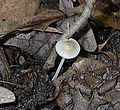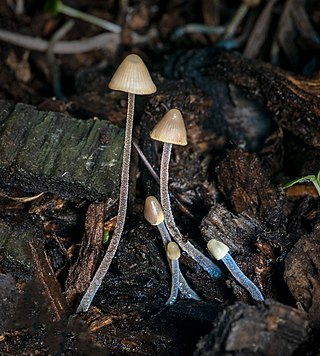
Mycena is a large genus of small saprotrophic mushrooms that are rarely more than a few centimeters in width. They are characterized by a white spore print, a small conical or bell-shaped cap, and a thin fragile stem. Most are grey or brown, but a few species have brighter colours. Most have a translucent and striate cap, which rarely has an incurved margin. The gills are attached and usually have cystidia. Some species, like Mycena haematopus, exude a latex when the stem is broken, and many species have a chlorine or radish-like odour.
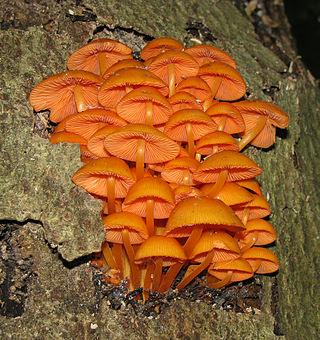
Mycena leaiana, commonly known as the orange mycena or Lea's mycena, is a species of saprobic fungi in the genus Mycena, family Mycenaceae. Characterized by their bright orange caps and stalks and reddish-orange gill edges, they usually grow in dense clusters on deciduous logs. The pigment responsible for the orange color in this species has antibiotic properties. A variety of the species, Mycena leaiana var. australis, can be found in Australia and New Zealand.

Mycena haematopus, commonly known as the bleeding fairy helmet, the burgundydrop bonnet, or the bleeding Mycena, is a species of fungus in the family Mycenaceae, of the order Agaricales. It is widespread and common in Europe, North America, and has also been collected in Japan and Venezuela. It is saprotrophic—meaning that it obtains nutrients by consuming decomposing organic matter—and the fruit bodies appear in small groups or clusters on the decaying logs, trunks, and stumps of deciduous trees, particularly beech. The fungus, first described scientifically in 1799, is classified in the section Lactipedes of the genus Mycena, along with other species that produce a milky or colored latex.

Mycena interrupta is a species of mushroom. It has a Gondwanan distribution pattern, being found in Australia, New Zealand, New Caledonia and Chile. In Australia, it is found in Victoria, Tasmania, New South Wales, South Australia, and Queensland, where its distribution is limited to Lamington National Park.
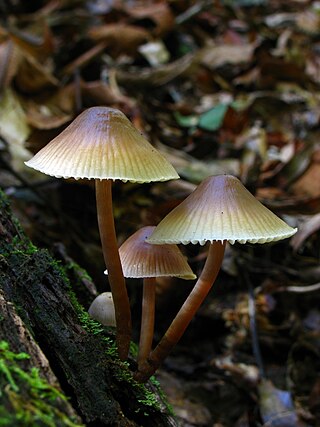
Mycena galericulata is a mushroom species commonly known as the common bonnet, the toque mycena, the common mycena or the rosy-gill fairy helmet. The type species of the genus Mycena was first described scientifically in 1772, but was not considered a Mycena until 1821. It is quite variable in color, size, and shape, which makes it somewhat difficult to reliably identify in the field. The mushrooms have caps with distinct radial grooves, particularly at the margin. The cap's color varies from grayish brown to dark brown and the shape ranges from bell-like to bluntly conical to flattened with an umbo. The stem is hollow, white, tough and thin, without a ring and often roots deeply into the wood on which it grows. The gills are white to grayish or even pinkish when mature and are connected by distinct cross-veins. The caps can reach 4 cm (1.6 in) in diameter, and have a mealy odor and taste. The spore print is white and the gills are pink at maturity, which can lead to possible confusion with species of the genus Pluteus. M. galericulata mushrooms grow mostly in clusters on the well-decayed stumps of deciduous and coniferous trees from spring to autumn. The species can generally be considered inedible. It is common and widespread in the entire temperate zone of the Northern Hemisphere, but it has also been reported from Africa.
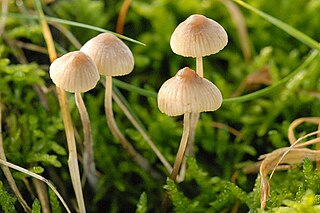
Atheniella flavoalba, which has the recommended name of ivory bonnet in the UK, is a species of agaric in the family Cyphellaceae. The cap is initially conical, before becoming convex and then flat; it may reach up to 1.5 cm (0.6 in) across. The cap is ivory-white to yellowish white, sometimes more yellowish at the center. The tubular stems are up to 8 cm (3.1 in) long and 2.5 mm (0.10 in) thick, and have long, coarse white hairs at their bases. Atheniella flavoalba is found in Europe, the Middle East, and North America, where it grows scattered in pastures or in dense groups under conifers and on humus in oak woods.

Mycena vitilis, commonly known as the snapping bonnet, is a species of inedible mushroom in the family Mycenaceae. It is found in Europe and North America, where it grows on the ground among leaves in damp places, especially under alder. The small pale gray to whitish fruit bodies are usually attached to small sticks buried in the leaves and detritus. They are distinguished by their long, slender stems that root into the ground, and by the grooved cap that reaches diameters of up to 2.2 cm (0.9 in). The grayish-white gills on the underside of the cap are distantly spaced, and adnately attached to the stem. M. vitilis contains strobilurin B, a fungicidal compound with potential use in agriculture.

Mycena sanguinolenta, commonly known as the bleeding bonnet, the smaller bleeding Mycena, or the terrestrial bleeding Mycena, is a species of mushroom in the family Mycenaceae. It is a common and widely distributed species, and has been found in North America, Europe, Australia, and Asia. The fungus produces reddish-brown to reddish-purple fruit bodies with conic to bell-shaped caps up to 1.5 cm (0.6 in) wide held by slender stipes up to 6 cm (2.4 in) high. When fresh, the fruit bodies will "bleed" a dark reddish-purple sap. The similar Mycena haematopus is larger, and grows on decaying wood, usually in clumps. M. sanguinolenta contains alkaloid pigments that are unique to the species, may produce an antifungal compound, and is bioluminescent. The edibility of the mushroom has not been determined.
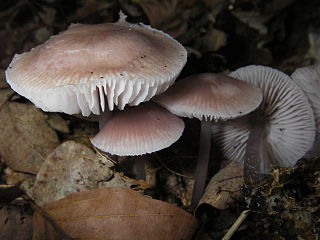
Mycena pura, commonly known as the lilac mycena, lilac bonnet, is a species of mushroom in the family Mycenaceae. First called Agaricus prunus in 1794 by Christian Hendrik Persoon, it was assigned its current name in 1871 by German Paul Kummer. Mycena pura is known to bioaccumulate the element boron.
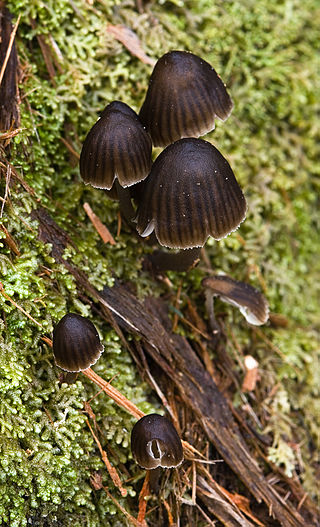
Mycena nargan, commonly known as the Nargan's bonnet, is a species of fungus in the family Mycenaceae, and the sole member of the section Nargan in the genus Mycena. Reported as a new species in 1995, it is known predominantly from Southern Australia. The saprobic fungus produces mushrooms that grow on well-decayed wood, often on the underside of wood lying in litter. The dark chestnut-coloured caps are covered with white, easily removed scales, and reach diameters of up to 2 cm (0.8 in) wide. The pale, slender stems are up to 5 cm (2.0 in) long and have white scales at the base. On the underside of the cap, the cream-coloured gills are widely spaced and bluntly attached to the stem. The edibility of the mushroom is unknown.

Mycena overholtsii, commonly known as the snowbank fairy helmet or fuzzy foot, is a species of fungus in the family Mycenaceae. The mushrooms produced by the fungus are relatively large for the genus Mycena, with convex grayish caps up to 5 cm (2 in) in diameter and stems up to 15 cm (6 in) long. The gills on the underside of the cap are whitish to pale gray, and initially closely spaced before becoming well-spaced at maturity after the cap enlarges. The mushrooms are characterized by the dense covering of white "hairs" on the base of the stem. M. overholtsii is an example of a snowbank fungus, growing on well-decayed conifer logs near snowbanks, during or just after snowmelt. Formerly known only from high-elevation areas of western North America, particularly the Rocky Mountain and Cascade regions, it was reported for the first time in Japan in 2010. The edibility of the mushroom is unknown. M. overholtsii can be distinguished from other comparable species by differences in location, or spore size.

Mycena fuscoaurantiaca is a species of mushroom in the family Mycenaceae. First reported as a new species in 2007, the diminutive mushroom is only found in Kanagawa, Japan, where it grows on dead fallen twigs in lowland forests dominated by hornbeam (Carpinus) and Chinese evergreen oak trees. The mushroom has a brownish-orange conical cap that has grooves extending to the center, and reaches up to 11 mm (0.43 in) in diameter. Its slender stem is colored similarly to the cap, and long—up to 60 mm (2.4 in) tall. Microscopic characteristics include the weakly amyloid spores, the smooth, swollen cheilocystidia and pleurocystidia with long rounded tips, the diverticulate hyphae of the cap cuticle, and the absence of clamp connections.

Mycena lanuginosa is a species of mushroom in the family Mycenaceae. First collected in 2000 and reported as a new species in 2007, it is known only from lowland oak-dominated forests in central Honshu in Japan. The small mushroom is characterized by its grooved, grayish-brown to violet-brown cap up to 11 mm (0.43 in) in diameter, and the slender grayish-brown to reddish-brown stem covered with minute, fine, soft hairs. The mushroom produces amyloid spores. Microscopic distinguishing features include the smooth, spindle-shaped cheilocystidia and pleurocystidia and the diverticulate elements in the outer layer of the cap and the stem.

Mycena multiplicata is a species of mushroom in the family Mycenaceae. First described as a new species in 2007, the mushroom is known only from Kanagawa, Japan, where it grows on dead fallen twigs in lowland forests dominated by oak. The mushroom has a whitish cap that reaches up to 13 mm (0.51 in) in diameter atop a slender stem 15 to 20 mm long by 1 to 1.3 mm thick. On the underside of the cap are whitish, distantly spaced gills that are narrowly attached to the stem. Microscopic characteristics of the mushroom include the amyloid spores, the pear-shaped to broadly club-shaped cheilocystidia covered with a few to numerous, unevenly spaced, cylindrical protuberances, the lack of pleurocystidia, and the diverticulate hyphae in the outer layer of the cap and stem. The edibility of the mushroom is unknown.

Mycena maculata, commonly known as the reddish-spotted Mycena, is a species of fungus in the family Mycenaceae. The fruit bodies, or mushrooms, have conic to bell-shaped to convex caps that are initially dark brown but fade to brownish-gray when young, reaching diameters of up to 4 cm. They are typically wrinkled or somewhat grooved, and have reddish-brown spots in age, or after being cut or bruised. The whitish to pale gray gills also become spotted reddish-brown as they mature. The stem, up to 8 cm (3 in) long and covered with whitish hairs at its base, can also develop reddish stains. The mycelium of M. maculata has bioluminescent properties. The saprobic fungus is found in Europe and North America, where it grows in groups or clusters on the rotting wood of both hardwoods and conifers. The edibility of the fungus is unknown. Although the species is known for, and named after its propensity to stain reddish, occasionally these stains do not appear, making it virtually indistinguishable from M. galericulata.

Mycena aurantiomarginata, commonly known as the golden-edge bonnet, is a species of agaric fungus in the family Mycenaceae. First formally described in 1803, it was given its current name in 1872. Widely distributed, it is common in Europe and North America, and has also been collected in North Africa, Central America, and Japan. The fungus is saprobic, and produces fruit bodies (mushrooms) that grow on the floor of coniferous forests. The mushrooms have a bell-shaped to conical cap up to 2 cm in diameter, set atop a slender stipe up to 6 cm long with yellow to orange hairs at the base. The fungus is named after its characteristic bright orange gill edges. A microscopic characteristic is the club-shaped cystidia that are covered with numerous spiky projections, resembling a mace. The edibility of the mushroom has not been determined. M. aurantiomarginata can be distinguished from similar Mycena species by differences in size, color, and substrate. A 2010 publication reported the discovery and characterization of a novel pigment named mycenaaurin A, isolated from the mushroom. The pigment is responsible for its color, and it has antibiotic activity that may function to prevent certain bacteria from growing on the mushroom.

Mycena arcangeliana is a species of Mycenaceae fungus. It has been known by a number of scientific names, and its taxonomy is still somewhat disputed. It produces small mushrooms with caps varying in colour from whitish to a darker grey-brown, and stems of an olive-greyish that fade with age. The mushrooms can be mistaken for the similar Mycena flavescens. They have a mild taste, but a strong smell of iodoform; they are not edible. The species grows on dead wood in autumn months, and can be found throughout Europe.
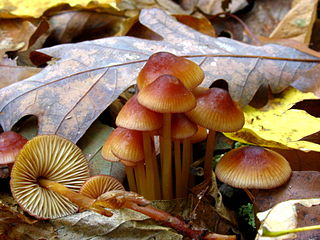
Mycena atkinsoniana is a species of agaric fungus in the family Mycenaceae. It is one of the so-called "bleeding mycenas" that will ooze yellow to orange juice when injured. Other distinguishing features include the upper stem surface that is decorated with tiny purplish-brown fibers, and the gills, which are pale yellow with maroon edges. The reddish-brown caps are smooth with a grooved margin, and up to 3 cm (1.2 in) wide. Mycena atkinsoniana is known from the United States and Canada, where it grows scattered or in groups on leaf litter in forests during the summer and autumn. It was originally described from collections associated with beech, but it is also frequently found under eastern North American oaks.

Mycena alcalina, commonly known as the alkaline mycena, or stump fairy helmet mushroom, is a species of fungus in the family Mycenaceae. It grows widely, ranging from North America to Europe.
Mycena subcyanocephala is a species of fungus, which has its habitat in the tropical parts of Taiwan. It has been spotted eight times. Mycena subcyanophala is the smallest mushroom in the world. It is about 1 mm tall. Mycena subcyanocephala also gathers a lot of humidity.






